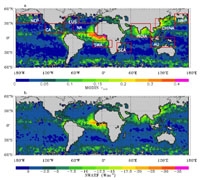Shortwave Aerosol Radiative Forcing over Cloud-Free Oceans from Terra: 2. Seasonal and Global Distributions

Using 10 months of collocated Clouds and the Earth's Radiant Energy System (CERES) scanner and Moderate Resolution Imaging Spectroradiometer (MODIS) aerosol and cloud data from Terra, we provide estimates of the shortwave aerosol direct radiative forcing (SWARF) and its uncertainties over the cloud-free global oceans. Newly developed aerosol angular distribution models (ADMs) (Zhang et al., 2005), specifically for different sea surface conditions and aerosol types, are used for inverting the CERES observed radiances to shortwave fluxes while accounting for the effect of aerosol optical properties on the anisotropy of the top of atmosphere (TOA) shortwave radiation fields. The spatial and seasonal distributions of SWARF are presented and the MODIS retrieved aerosol optical depth (τ) and the independently derived SWARF show a high degree of correlation and can be estimated using the equation SWARF = 0.05 - 74.6τ + 18.2τ2 Wm-2 (τ < 0.8). The instantaneous TOA SWARF from Terra overpass time is -6.4 ± 2.6 Wm2 for cloud-free oceans. Accounting for sample biases and diurnal averaging, we estimate the SWARF over cloud-free oceans to be -5.3 ± 1.7 Wm2, consistent with previous studies. Our study is an independent measurement-based assessment of cloud-free aerosol radiative forcing that could be used as a validation tool for numerical modeling studies.